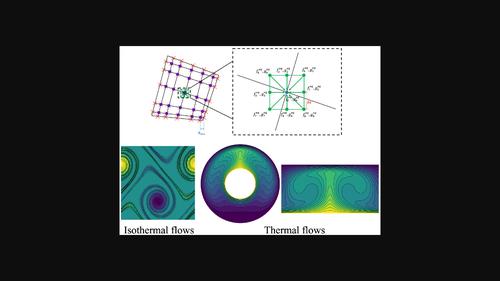Development of a Fourier‐expansion based differential quadrature method with lattice Boltzmann flux solvers: Application to incompressible isothermal and thermal flows
IF 1.7
4区 工程技术
Q3 COMPUTER SCIENCE, INTERDISCIPLINARY APPLICATIONS
引用次数: 0
Abstract
This paper presents a high‐order Fourier‐expansion based differential quadrature method with isothermal and thermal lattice Boltzmann flux solvers (LBFS‐FDQ and TLBFS‐FDQ) for simulating incompressible flows. The numerical solution in the present method is approximated via trigonometric basis. Therefore, both periodic and non‐periodic boundary conditions can be handled straightforwardly without the special treatments as required by polynomial‐based differential quadrature methods. The incorporation of LBFS/TLBFS enables the present methods to efficiently simulated various types of flow problems on considerably coarse grids with spectral accuracy. The high‐order accuracy, efficiency and competitiveness of the proposed method are comprehensively demonstrated through a wide selection of isothermal and thermal flow benchmarks.

开发基于傅立叶膨胀的微分正交法与晶格玻尔兹曼通量求解器:不可压缩等温流和热流的应用
本文提出了一种基于微分正交的高阶傅立叶膨胀法,并采用等温和热晶格玻尔兹曼通量求解器(LBFS-FDQ 和 TLBFS-FDQ)模拟不可压缩流动。本方法的数值解通过三角函数近似。因此,周期性和非周期性边界条件均可直接处理,无需进行基于多项式的微分正交方法所要求的特殊处理。LBFS/TLBFS 的加入使本方法能够在相当粗的网格上有效地模拟各种类型的流动问题,并具有频谱精度。通过广泛选择的等温和热流基准,全面展示了所提方法的高阶精度、效率和竞争力。
本文章由计算机程序翻译,如有差异,请以英文原文为准。
求助全文
约1分钟内获得全文
求助全文
来源期刊
CiteScore
3.70
自引率
5.60%
发文量
111
审稿时长
8 months
期刊介绍:
The International Journal for Numerical Methods in Fluids publishes refereed papers describing significant developments in computational methods that are applicable to scientific and engineering problems in fluid mechanics, fluid dynamics, micro and bio fluidics, and fluid-structure interaction. Numerical methods for solving ancillary equations, such as transport and advection and diffusion, are also relevant. The Editors encourage contributions in the areas of multi-physics, multi-disciplinary and multi-scale problems involving fluid subsystems, verification and validation, uncertainty quantification, and model reduction.
Numerical examples that illustrate the described methods or their accuracy are in general expected. Discussions of papers already in print are also considered. However, papers dealing strictly with applications of existing methods or dealing with areas of research that are not deemed to be cutting edge by the Editors will not be considered for review.
The journal publishes full-length papers, which should normally be less than 25 journal pages in length. Two-part papers are discouraged unless considered necessary by the Editors.

 求助内容:
求助内容: 应助结果提醒方式:
应助结果提醒方式:


